 |
Carlos
Gomes, born in Criciúma, state of Santa Catarina, is 59
years old and is an electrical engineer.
He became orchidist 27 years ago and approximately since 10 he
has a commercial nursery.
He is fond of Laelia purpurata and Cattleya intermedia
and has been making successive crosses aimed to improve those
species.
From this passion have resulted, in addition to plants such as
Laelia purpurata 'Beautiful' and Cattleya intermedia
'Bewitched', theoretical work as the "Varieties classification
of Cattleya intermedia" and " Criterions of Judgment
and punctuation in
Cattleya intermedia", both presented in this edition.
|
ON: How
began your attraction to orchids?
CG: Everything started with the observation of bloomed L. purpuratas,
C. intermedias and C. leopoldiis when I was fishing in Santa Catarina
Island. They were in the woods and mainly in the cliffs of the island.
At that time, early 1980's, there were still many native plants and
original habitats now devastated by urban growth. With the increased
interest in such different and so beautiful plants, it did not take
long for us to visit exhibitions and soon starting to buy plants and
making friends among the orchid growers in Florianopolis. Soon we were
fond of orchids.
ON: When you said "we", you mean who else?
CG: I mean the nursery, every one who works there, myself, my wife,
my two daughters, beside the employee.
ON: You were not limited to nurseries in the south, how have you found
out the others? At that time, communication was very slow, not like
now with internet...
CG: As at the time, we traveled a lot to Rio de Janeiro to work, we
soon discovered Binot and Florália nurseries in Petropolis, where
we became friends with Mr. Jorge Verboonen and Luis, respectively, very
nice and thoughtful people. There were many visits over many years which
allowed us to have a good collection of species, both Brazilian and
foreign. This also helped to form our predilection for the species and
not for hybrids.
ON: You have a proposal for classifying and criteria for judging Cattleya
intermedia. How did this idea appear?
CG: The idea of making a proposal for the classification of C. intermedia
and also from L. purpurata arose from the need to have rules
more transparent and easier to be understood by the judges, during the
exhibitions, here in Santa Catarina.
The old rules were outdated and too simplistic to describe the varieties,
creating doubt and confusion during the judgments.
With C. intermedia was worst as this species possesses a variety
trilabellum and its variations, causing much confusion in the beginner
and older orchidists. I believe that the biggest contribution to the
proposed classification of C. intermedia was to clarify the mechanism
of variation in flower shapes, I mean, varieties peloric, aquinii, flamea,
georgiana and bergeriana. These last two names honor two great experts
and collectors of C. intermedia from Rio Grande do Sul, Otto
Georg and Alceu Berger.
ON: And about the crosses?
CG: Around 1986, we started making the first crosses, mainly L. purpurata,
passion of all orchid growers by this time in Santa Catarina. It was
the beginning of another passion that continues today, the improvement
of species.
At that time, almost all plants had been collected. Few people made
crosses and good matrices were rare besides it was impossible to a beginner
to obtain them. Nearly ten years later, in partnership with a great
friend and orchidist from Florianopolis, Claudio Deschamps, also fond
of L. purpurata, we began to buy matrices from orchid growers
in Rio Grande do Sul, mainly plants from Dr. Haetinger, the famous 'red'
(Flamea, striata and sanguinea). The prices were outrageously high!
Any rootless back cost a thousand dollars! Anyway, they didn't sell
to anyone.
ON: Making a parenthesis, you mentioned Deschamps, who died in 2008,
precisely during the Orchid Show in Joinville, what could you tell about
him?
CG: Claudio Deschamps was an orchidist friend of mine who for over twenty
years shared all the work we did for the improvment of L. purpurata
and C. intermedia. Fanatic fond of purpurata (purpurateiro as
we said in Brazil), he had one of the best collections of L. purpurata
in southern Brazil. In private life, he started as a mason and became
owner of one of the largest construction companies in Florianopolis.
Simple and friendly person, he was always willing to help the beginners
and when possible, he gave seedlings of the plants which sometimes had
cost a fortune. If he wanted a L. purpurata, he did everything to get
it, it was rare not to succeed. This is how he got many of the famous
'Dr. Haetinger's red', for exchange or even paying a small fortune,
when someone decide to sell them. He really had a true passion for L.
purpurata! What a pity that in November 12, 2008, has died, a victim
of cancer, in full bloom of L. purpurata he loved so much!
ON:We must not allow to be forgotten people like him ... Continuing
talking about the crosses, how the evolution gets to that point?
CG: It took us years to acquire the confidence of some orchid growers
and succeed in purchasing plants. But from there, using these and other
matrices, plants began to get very good, surprising even the most exigent
orchidist.
ON: And then you became a professional?
CG: Soon we had to start to deal in plants, because besides the great
demand from friends, the cost had become prohibitive for just a hobby.
So we created Lapurpurata nursery later changed to Carlos Gomes Nursery
as called by many people.
ON: And the choice of matrices?
CG: Since the beginning, we use only the best breeders. Looking at the
crosses of many nurseries, over the years, we found that the percentage
of plants good or excellent in technical terms, it was always very low.
As we bought many seedlings from various producers, Deschamps and I
were disappointed with the results. And when we traveled to exhibitions
in Rio de Janeiro, Sao Paulo, Parana, Santa Catarina and Rio Grande
do Sul, we took the opportunity to plan the crosses that we thought
were the best. It happens that many of the matrices we thought we hadn't
in our collections, and many of them were not even on sale, because
they belonged to orchidist too exclusive. So it took us years to get
good matrices for L. purpurata as well as C. intermedia.
ON:
It seems that
the beginning was not easy. When and how things
started to change?
CG: In the late 1990s, things began to change, because we got
an exceptional L. purpurata, which we called 'tipão
Deschamps' because it was a purpurata very large and so unusual
for that time, being much better than the legendary L. purpurata
'Milionária'. From this plant, we got many matrices,
dreamed for decades. Soon, the crosses made with these matrices
presented exceptional results. Then we got matrices of C. intermedia,
also desired for many years. Nowadays we have incredible results
with these matrices of C. intermedia some of them already in the
third generation. These results were obtained by the use of good
matrices and constant observation, year after year, of the result
of crosses, both our own and other breeders. |
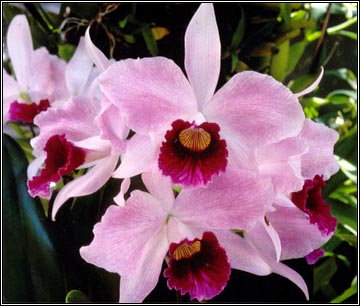
L.
purpurata 'tipão Deschamps' (photo: Francisco Miranda) |
ON: What
do you aim ?
CG: We aim to produce plants of superior quality. So we don't work with
common plants. characteristics that may contribute to aim the objectives
of each cross. Every cross is subject of studies and discussions with
other orchid growers and breeders, always seeking the production of
superior plants.
ON: What are your criteria for choosing the matrices?
CG: For matrices, the choice is always in early flowering plants, ease
of growth and of course with great technical shape, that is, round flowers
with sepals and petals rounded and flat, perfect lip for the species
and always typical color of the variety.The plan must also have a good
inflorescence and several flowers, always compatible with the species.
Furthermore, we avoid, where possible crosses between different varieties,
except when the aim is exactly this one.
ON: What is essential you do a cross?
CG: The key is to always have an aim in every cross! Never cross two
plants just to see what happens. This is a common mistake! If we do
not have a minimum of information about the matrices, the result is
almost always bad, that is, a small percentage or no good plant at all.
ON: Your crosses are always concentrated in Laelia purpurata?
CG: The largest amount of crosses we do is L. purpurata, which is the
most widely cultivated plant here in southern Brazil. Then comes the
C. intermedia that dispute with L. purpurata the preference of the orchidist
from the south. But in recent years we have also worked with C. leopoldii,
C. labiata, C. forbesii and other Cattleya and Laelia
in a lesser extent, always conditioned to have good matrices.
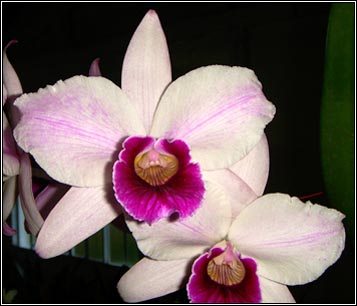
Laelia purpurata 'Magnifica' |
ON:
What results you have obtained?
CG: Of course, during all those years had the privilege of seeing
spectacular flowering plants, both of L. purpurata and
Cattleya intermedia. In 2005, it bloomed a L. purpurata
we never thought possible! In perfect shape and color, inflorescence
and number of flowers ideal! Something that always dreamed of
but we doubt whether it was possible to produce, even with wonderful
matrices that we had.
Today I consider it the best Laelia purpurata of all time!!
The name? 'Magnífica' (Magnificent).
|
ON:What
other results in
Cattleya intermedia, you can mention?
CG: As
we began to cross the C. intermedias much later than purpurata, the
crosses are the most recent. Nevertheless, the
results have surprised us even in the first generations. What was somehow
expected, since it only started to invest in Cattleya intermedia
when we get some exclusive matrices like 'Figueirinha', 'Quantum', 'Milionária',
'Xodozinho', etc. matrices dreamed for so long an also due to the precocity
of blooming.
We can mention the cross 522 - C. intermedia 'Figuerinha' X C.
intermedia 'tipão 999' which gave round petals and big number
of flowers
523 - C. intermedia 'Figueirinha' X C. intermedia orlata
'WTC', besides de type flowers with wide petals also gave very good
"orlatas".
The crosses 652 - C. intermedia 'pétala larga 999CD' (wide
petals 999CD) X C. intermedia 'Xodozinho' and 742 - C. intermedia
'Xodozinho' X C. intermedia 'Figueirinha' gave some of the round
C. intermedias we have never imagined possible in the species.
Such as 'Feiticeira' (mentioned above), 'Memória Claudio Deschamps'
and many other. Many plants had exceptional flowers but one of
them overcame all! It was the first C. intermedia type we saw
with petals touching each other and with a shape like C. walkeriana
'Feiticeira'. They are so similar that we decided to give the same name.
So, now known as C. intermedia 'Feiticeira' and is still one
of the best plants we have this species.
For those who began collecting C. intermedias native, it was impossible
to think that a flower could one day have them this shape.
|
|
522-C.
intermedia 'Figuerinha' X C. intermedia 'tipão
999'
|
523 - C. intermedia 'Figueirinha' X C. intermedia
orlata 'WTC' |
|
652 - C. intermedia 'pétala larga 999CD' X C. intermedia 'Xodozinho' |
|
|
C.
intermedia 'Memória Claudio Deschamps' |
C. intermedia 'Feiticeira' |
ON: And
the most outstanding Laelia purpurata?
CG: There were many crossings, both L. purpurata and C. intermedia,
which gave good results. About L. purpurata, we can add the
cross 327 - L. purpurata 'Milionária self' X L. purpurata
'tipão Deschamps', which gave wonderful types in a percentage
of good plants we have never seen before. The cross 333 - L. purpurata
semi-alba 'S30 Tessmer' X L. purpurata oculata
'Pedreira 4N', gave a high percentage of
semi-alba with excellent shapes. Until today people ask for this cross,
sold out for other 5 years. In the lineage of the red we can mention
the crosses 279 - L. purpurata. flamea 'Petersen' X L.
purpurata flamea 'Ewelin' and 340 -
L. purpurata flamea 'Escura do Otto' X L. purpurata
flamea 'Haetinger 884/51', which resulted in striata, flamea
and wonderful sanguinea and which allowed many orchid growers to buy
to these varieties, so hardy to be found by this time, around the year
2000. More recently, the cross 658 - L. purpurata '327 Grande'
X L. purpurata 'Ana Clara', which is generating wonderful light
types.
|
|
327L.
purpurata 'Milionária self' X L. purpurata 'tipão
Deschamps' |
333 - L. purpurata semi-alba 'S30 Tessmer' X L. purpurata oculata 'Pedreira 4N' |
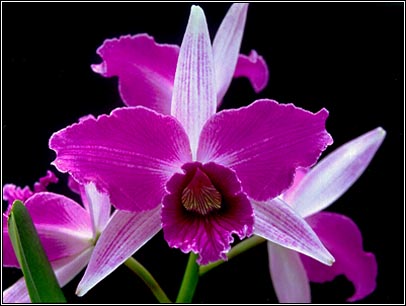 |
279 - L. purpurata. flamea 'Petersen' X L. purpurata flamea 'Ewelin' |
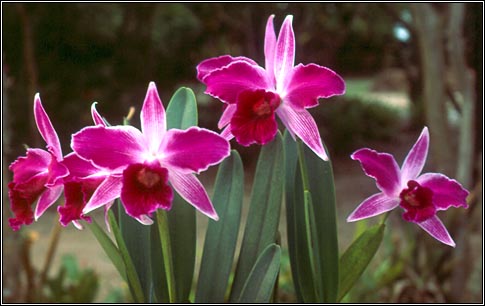 |
340 - L. purpurata flamea 'Escura do Otto' X L. purpurata flamea 'Haetinger 884/51' |
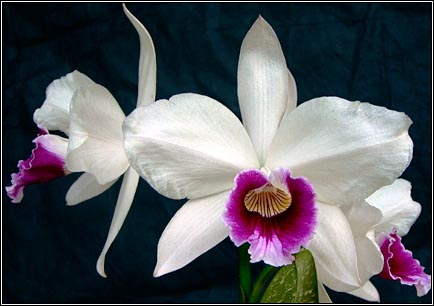 |
658 - L. purpurata '327 Grande' X L. purpurata 'Ana
Clara' |
ON: What
you got in C. leopoldii?
CG: I think we had better to leave for another article, because it is
a long history, including the discovery of the C. leopoldii trilabellum
'Garibaldi' and its use as a matrix, generating a progeny of flamea
and trilabelloid.
ON: This quest for perfection does not end. What we can still expect?
CG: Every year we still see many C. intermedia and L. purpurata
blooming and every year we make dozens of crosses with the best plants.
At the moment, we are preparing for having more than two thousand C.
intermedia blooming! And the same number of L. purpurata in
November!
A dream for any orchid grower!
Expressly
prohibited any use of any material from this site (text, photos,
images, layout and others), without the express permission of the
authors, under penalty of prosecution. Any information or request
by e-mail
bo@sergioaraujo.com |
 |